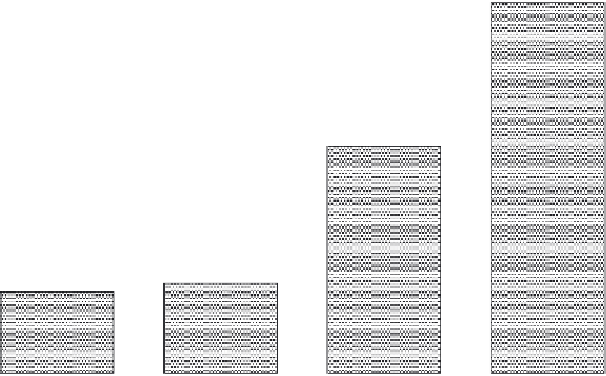Geoscience Reference
In-Depth Information
4.5
4
3.5
3
2.5
2
1.5
1
0.5
0
Land needed for food
1961
Land needed for food
2004
Land needed in 2004
at 1961 intensity
Global estimate of
potential land for food
Fig. 7.7
Landforglobalfoodproduction;croplandversusintensiication.AfterMooneyetal.(2005).
of endangered species and listing protected areas, but this is different to a global
analysis of the spatial distribution of all mammals. The Ceballos team compiled the
geographic ranges of all 4795 known species of land mammal. They then linked this
to cells, rectangles of 10 000 km
2
each. They found that 1702 cells of land would
conserve at the very least 10% of the range of each species; this 10% is a critical
threshold that many conservation biologists use as the minimum of a species' natural
range needed to conserve a viable population. The spatial detail of the 1702 cells
is, unfortunately, too coarse for it to be used in practical conservation management.
However, 1702 cells is roughly equal to 11% of the Earth's ice-free land surface and
provides an indication of the scale of the problem. That around 80% of the critical
1702 cells are already used for agriculture demonstrates the imposition of human
food demands on conservation. Conversely, looking at some 250 conservation scen-
arios, 95% of these cells can be replaced by other cells without loss of conservation
value, and only 135 cells (
1%) are irreplaceable; that is, were required in all 250
conservation scenarios. Of these, those located in wealthy countries (which have
the resources for implementing developed, sustained conservation programmes) are
most likely to succeed, whereas extinction risks are higher for cells in less-developed
nations.
Another key question is how, as opposed to where, should finite conservation effort
be focused? A long-running debate in conservation biology has been whether efforts
should be area-based (say, conserving a region as a national park or World Heritage
Site) or based on a species: such are often called flagship species (a famous example
is the giant panda,
Ailuropoda melanolueca
). Marcel Cardillo, Georgina Mace and
colleagues (2005) looked at 4000 species of terrestrial mammal. They looked at
three principal groupings of predictors of extinction risk: (1) environmental factors
such as size and range of species, (2) species' ecological traits such as population
<



















Search WWH ::

Custom Search